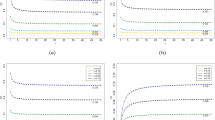Abstract
Although statistical process control (SPC) techniques have been focused mostly on detecting constant mean shifts, dynamic and time-varying process changes frequently occur in the monitoring of feedback-controlled and autocorrelated processes. In this research, the performances of cumulative score (Cuscore), generalized likelihood ratio test (GLRT), and cumulative sum (CUSUM) charts in detecting a dynamic mean change that finally approaches a steady-state value are compared. Theoretical results in average run length (ARL) comparison are provided. From the theretical study we find that, when the steady-state value is greater or less than a critical value,Rδ/2+δ/2, the Cuscore and CUSUM charts have a different performance in detecting the mean change. We prove also that the GLRT has the best performance among the three charts in detecting any mean change for which the steady-state value is not equal to δ or δR, when the in-control ARL is large.
Similar content being viewed by others
References
Alwan, L. C. and Roberts, H. V. (1988). Time-series modeling for statistical process control,Journal of Business Economic Statistics,6, 87–95.
Apley, D. W. and Shi, J. (1994). A statistical process control method for autocorrelated data using a GLRT,Proceeding of the International Symposiumon Manufacturing Science and Technology for 21st Century, 165–170, Tsinghua Press Beijing.
Apley, D. W. and Shi, J. (1999). The GLRT for statistical process control of autocorrelated processes,IIE Transactions,31, 1123–1134.
Bagshaw, M. and Johnson, R. A. (1977). Sequential procedures for detecting parameter changes in a time-series model,Journal of the American Statistical Association,72, 593–597.
Box, G. E. P. and Luceño, A. (1997).Statistical Control by Monitoring and Feedback Adjustment, Wiley, New York.
Box, G. E. P. and Ramírez, J. G. (1992). Cumulative score charts,Quality Reliability Engineering International,8, 17–27.
Esary, J. D., Proschan, F. and Walkup, D. W. (1967). Association of random variables with applications,The Annals of Mathematical Statistics,38, 1466–1474.
Fisher, R. A. (1925). Theory of statistical estimation,Proceeding of the Cambridge Philosophical Society.22, 700–725.
Hu, S. J. and Roan, C. (1996). Change patterns of time series-based control charts,Journal of Quality Technology,28, 302–312.
Keats, J. B., Montgomery, D. C., Runger, G. C. and Messina, W. S. (1996). Feedback control and statistical process monitoring,International Journal of Reliability, Quality, and Safety Engineering,3(2), 231–241.
Lai, T. L. (1974). Control charts based on weighted sums,The Annals of Statistics 2, 134–147.
Luceño, A. (1999). Average run lengths and run length probability distributions for cuscore charts to control normal mean,Computational Sttistics & Data Analysis,32, 177–195.
Montgomery, D. C. and Mastragelo, C. M. (1991). Some statistical process control charts methods for autocorrelated data.Journal of Quality Technology,23, 179–193.
Moustakides, G. V. (1986). Optimal stopping times for detecting changes in distribution.The Annals of Statistics,14, 1379–1387.
Ramírez, G. J. (1998). Monitoring clean room air using Cuscore charts.Quality Reliability Engineering International,14, 281–289.
Ritov, Y. (1990). Decision theoretic optimality of the Cusum procedure,The Annals of Statistics,18, 1464–1469.
Shu, L. J., Apley, D. W. and Tsung, F. (2002). Autocorrelated prodess monitoring using triggered Cuscore charts,Quality and Reliability Engineering International,18, 411–421.
Siegmund, D. and Venkatraman, E. S. (1995). Using the generalized likelihood ratio statistic for sequential detection of a change-point,The Annals of Statistics,23, 255–271.
Tsung, F. and Tsui, K.-L. (2003). A mean shift pattern study on integration of SPC and APC for process monitoring,IIE Transactions,35, 231–242.
Tsung, F., Shi, J. and Wu, C. F. J. (1999). Joint monitoring of PID controlled processes.Journal of Quality Technology,31, 275–285.
Vasilopoulos, A. V. and Stamboulis, A. P. (1978). Modification of control chart limits in the presence of data correlation,Journal of Quality Technology,10, 20–30.
Wardell, D. G., Moskowitz, H. and Plante, R. D. (1992). Control charts in the presence of data correlationManagement Science,38, 1084–1105.
Wu, Y. H. (1994). Design of control charts for detecting the change,Change—Point Problems, (eds. E. Carlstein, H. Muller and D. Siegmund),23, 330–345, Institute of Mathematical Statistics, Hayward, California.
Yashchin, E. (1993). Performance of CUSUM control schemes for serially correlated observations,Technonmetrics,35(1), 37–52.
Author information
Authors and Affiliations
About this article
Cite this article
Han, D., Tsung, F. Comparison of the cuscore, GLRT and cusum control charts for detecting a dynamic mean change. Ann Inst Stat Math 57, 531–552 (2005). https://doi.org/10.1007/BF02509238
Received:
Revised:
Issue Date:
DOI: https://doi.org/10.1007/BF02509238




